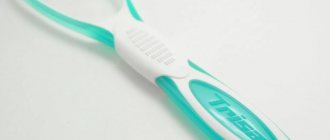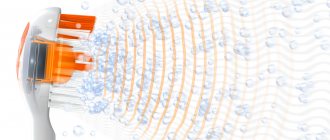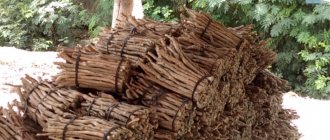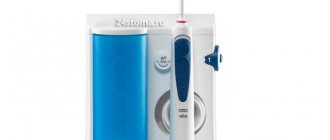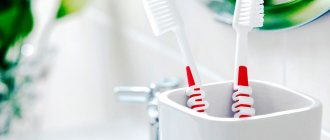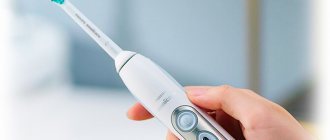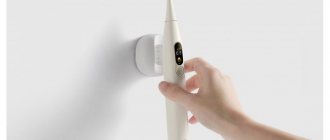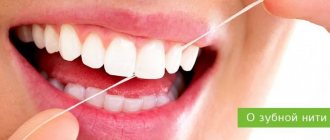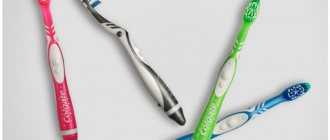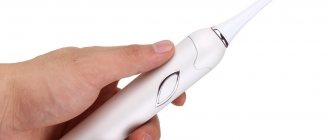From this article you will learn:
- When should you start brushing your baby's teeth under one year old?
- how to brush children's teeth at one year, 2 years and later,
- how to choose toothpaste for a child.
Baby teeth are very important for a child, because... they ensure jaw growth and also participate in the formation of correct pronunciation (diction). However, many parents make a number of mistakes that lead to early damage to baby teeth by caries, the subsequent development of pulpitis and periodontitis, and ultimately removal. At the same time, early removal of baby teeth causes disruption of jaw growth and delay in the eruption of permanent teeth.
Early caries of primary teeth is a consequence of - 1) insufficient oral hygiene in a child, which leads to the accumulation of soft plaque and an increase in the number of cariogenic bacteria, 2) improper diet, irregular feeding on demand or night feeding, 3) consumption of large quantities easily -digestible carbohydrates. There is even a term in dentistry - bottle caries, which shows the important connection between a child’s poor nutrition and the development of dental caries.
Caries of primary teeth in children -
Therefore, it is very important for parents to know when to start brushing their baby’s teeth, what toothpaste is best to use, and, in the future, how to teach their child to brush his teeth on his own when he reaches the appropriate age. Remember that soft flour and starchy foods (i.e., everything that contains easily digestible carbohydrates), sour and sweet juices, as well as soda - in conditions of insufficient hygiene quickly lead to the development of caries.
When to start brushing your baby's teeth
Hygienic care is necessary even before teething. The procedure must be carried out several times a day: after sleep and during the day after feeding.
The procedure for cleaning your baby's gums is as follows:
- place the child on your lap;
- take a gauze swab and carefully walk it over the surface of the gums. For greater convenience, you can wrap your finger with a bandage or use special finger pads, which can be purchased at the pharmacy.
It is enough to simply moisten the tampon with clean water, but for greater effect you can use foam designed just for such purposes (for example, SPLAT Junior (SPLAT Junior) for children 0-4 years old).
Foam is a modern, effective product that has many beneficial properties. Firstly, it contains lactic enzymes that protect the mucous membrane from infection and bacteria that cause various diseases (for example, stomatitis). Secondly, components such as creatine, arginine and others have an anti-inflammatory and calming effect, reducing pain during teething. Thirdly, many foams contain calcis or fluoride in small dosages (the former are best used before a year, the latter - after).
Peculiarities
Cloth napkins are a disposable device. Does not contain chemical, aggressive components, has a pleasant taste. But still, consult your pediatrician before use.
The silicone fingertip looks like a transparent cap. Can be used many times. The surface is covered with short tubercles.
The special feature is that you put it on your finger and cleanse it. Another ability is that the device gently removes plaque from the enamel and mucous membranes, and uses the villi to massage the gums.
Parents have different opinions on the use of silicone or rubber fingertips. For some reason, many are sure that they injure the delicate mucous membrane of the child’s mouth. But this is a misconception. First, cleanse gently, without force or pressure. Secondly, the fingertip is made of safe silicone, which prevents mechanical damage. It is also advisable to use it during teething, when the gums swell. And your pediatrician or pediatric dentist will tell you about this.
Also watch a video from Beauty Ksyu’s channel about how she uses a fingertip:
Thanks to the silicone fingertip, the following processes occur in the baby’s mouth:
- stagnation in gum tissue is eliminated;
- blood circulation in the gums and mucous membrane improves;
- gums are strengthened;
- Bleeding, swelling, and inflammation are prevented.
Massage also promotes faster and easier teething in babies.
Brush your child's teeth correctly
Teeth begin to erupt at about 6 months of age. Some children easily survive this period of time, others suffer from pain and experience great inconvenience.
Emerging teeth can be cleaned, just like the gums in the first months of a baby’s life: take a gauze swab, apply a special foam to it and rub it over the surface of the gums and teeth. Sometimes you can find finger pads with soft bristles on sale: they make the procedure much faster, better and more convenient.
Perhaps the baby will not like the procedure at first: you should not force things - it is better to give the child the opportunity to get used to it. When the baby is no longer nervous at the sight of tampons, you can move on to using a brush (there is no exact time frame for when exactly this should be done). You can hear from some dentists that it is advisable to use a brush after the appearance of at least 4 teeth in a row, others advise not to rush, waiting until the baby is 2 years old.
Description
Since the baby cannot independently perform hygiene procedures, this most important function falls on the shoulders of his parents. When choosing a silicone fingertip, consider the following points:
The accessory must be completely silicone, including the bristles. This will keep the baby healthy and not damage the soft tissues of the oral cavity. It is easier for the parent to control the force of pressure on the teeth and gums.
The presence of even slightly noticeable seams on the surface of the product is not allowed. There is a huge risk of various microorganisms and bacteria harmful to health appearing at these joints.
The fingertip must be equipped with a special case where the accessory will be stored.
Brushing your teeth
Cleaning should be done after waking up and before going to bed. The duration of the procedure is at least 2-3 minutes. Particular attention should be paid to chewing teeth, since they contain small grooves where bacteria accumulate and caries begins to form.
Not all children enjoy brushing their teeth: some may become capricious, nervous, and break out. First of all, you need to make sure that the fear goes away: brushing your teeth can be turned into a game, for example, you can let your child brush your teeth, and you brush them for him.
High-quality toothpaste and brush are of no small importance for hygiene, but their use is clearly not enough: once a day you need to floss (by the way, this advice applies not only to children, but also to adults). Floss can remove small food debris from dental spaces that are difficult to reach with a brush. Carious formations appear primarily in such places, since an excellent environment for the growth of bacteria is created there.
What foods are good for your first teeth?
Foods rich in calcium
.
First of all, it is cottage cheese and hard cheese. Slightly less calcium is found in milk, fermented milk products, green leafy vegetables, gooseberries, currants, and cherries. Sources of vitamin D, without which calcium cannot be absorbed, are egg yolk and butter. You should include carbohydrate foods in your child’s diet less often: bread, potatoes, and especially sugar and sweet foods. Sweets provoke the active proliferation of bacteria in the mouth, which leads to early caries
. “The longer you don’t offer your child sweets, the better,” says Kuznetsova, “for example, children under three years old should not be given chocolate at all.”
Which toothbrush should you choose?
Children's toothbrushes, without exception, have soft bristles. It is distinguished from an adult brush by a smaller head, which can be rubberized, which is done to reduce the risk of injury during the cleaning process.
The packaging of most brushes for children contains information about the age they are intended for: these recommendations should not be neglected. It is better to choose a brush with an unusual design that can attract the child’s attention and make him more willing to brush his teeth.
The brush should be changed once every 3 months, or better yet more often: you need to monitor the condition of the bristles, and not hesitate to replace them when they begin to deteriorate. The point here is not only the lack of aesthetics, but also the loss of functional qualities: if the bristles are fluffy, then it will be difficult to remove plaque, which is fraught with unpleasant consequences.
Each family member should have their own brush!
Recently, electric toothbrushes have become increasingly popular. There are special children's brushes that can be used after 3 years. Practice shows that children show more interest in electric toothbrushes than in regular ones. Again, each child should have their own personal attachment.
How to choose a product?
First of all, you need to pay attention to the material. It should be durable , but at the same time soft , so that the brush does not scratch or injure the baby’s sensitive gums.
You should know! Nowadays brushes are made of silicone.
Choosing the right thing is not so difficult, because all models are almost the same. They may vary in color and the presence of additional accessories.
It is recommended to buy those brushes that are sold with the case.
In this case, over time, when the brush deteriorates, it will be possible to purchase a new one, but without the case, since it was left over from the previous one.
Thanks to the container, the transparent fingertip is unlikely to get lost.
In most cases, all brushes are the same size.
It is recommended to buy the product in specialized stores , and even better - in pharmacies .
If the item was sold without a case, then it will need to be stored in a separate open cup. In this case, the end of the brush with bristles should be located at the top and “breathe”.
Know! A finger brush is also better than a traditional one because it can be replaced as it wears out.
Which pasta should you choose?
Before buying toothpaste, many modern parents go online to read reviews, but you shouldn’t trust them: many reviews are left on request in order to increase sales. The advertising is aimed primarily at women, since they are usually the ones who buy such things.
The main myth that can often be found in such reviews is the enormous harm of fluoride for children.
Fluoride or calcium: which is better for a child?
Fluoride is not poison at all. This substance is beneficial, including for children. Dental societies in many countries around the world have conducted studies that have proven that fluoride-containing toothpastes are absolutely not harmful.
You can often see that children should use a paste containing calcium, but this is not at all true.
When choosing pasta, you need to take into account the age of the direct consumer.
- Children under 1 year. This is the only age when it is better to purchase a paste with calcium in its composition, since during this period of time the tooth enamel is still quite weak and contains few minerals. Children often swallow the paste, so it should not contain parabens and sodium lauryl sulfate, which pose a health hazard. Fluoride-containing paste can be dangerous only where there is an increased fluoride content in the water: an excess of this substance can cause the development of fluorosis. If a filter is used, it can retain most of the fluoride, which will lead to its deficiency and, as a consequence, the development of caries. Read more about children's toothpastes here.
- Children from one to 6 years old. During this period, you can use a paste with fluoride, making sure that its content in the composition does not exceed 500 ppm. Pastes with calcium can also be used, provided that the child either does not have caries at all, or a single case of carious formation has been recorded.
- Children over 6 years of age. For children of this age, the concentration of fluoride contained in the paste should be increased to 1000 ppm.
Advice for parents who want to rid their child of dental problems:
- It is better to alternate different pastes: use a paste with calcium in the morning, and one with fluoride in the evening.
- You can get by with a calcium paste, but after each brushing, rinse your mouth with a special fluoride-containing liquid. Remember that such a liquid cannot replace a thorough cleaning!
Proper care
Important! If you follow the rules of caring for your finger brush, it will last as long as possible. To do this you need:
- Wash the product with soap after each cleaning.
- Store the massage brush in a special case so that it is always clean. Before placing the product in a container, it must be dried.
- Avoid steam treatment of the brush , as well as boiling. This is explained by the fact that silicone is a synthetic compound in which there is virtually no growth of pathogenic microflora. In addition, due to the steam, the silicone will begin to deform, and this will lead to the fact that the brush will need to be thrown away.
Reference! If the brush has a case, then storing it will be much easier, since most often it has a special clip with which the product can be secured to various thin surfaces.
For example, for the strap of a bag or for a shelf in the bathroom.
On average, the service life of a fingertip is 2-3 months . If the brush is deformed or damaged, it must be replaced.
Pastes to relieve painful symptoms during teething
There are several toothpastes designed to reduce the pain associated with teething.
In addition to the paste indicated at the very beginning of the article, we can recommend:
- Gel paste “Weleda” (Weleda) with calendula;
- ROCS Baby (ROKS Baby) with chamomile extract.
Both products will help your baby cope with pain.
Pastes for children with stomatitis
Stomatitis occurs quite often in children. It is much easier to prevent the occurrence of a disease than to treat it later.
High mucosal immunity is the best protection against stomatitis. Enzymes (lactoferrin, lysozyme, etc.) included in the composition of children's pastes from SPLAT: Junior and Juicy Set have a beneficial effect on the immune system.
What happens if you don't brush your teeth well enough?
Some parents are not serious about brushing their children's teeth, believing that the child is already fine, which is a misconception.
Poor hygiene is a consequence of the appearance of microbial plaque and stone formation, which can cause:
- gingivitis;
- caries;
- stomatitis;
- pulpitis;
- formation of purulent seals on the gums.
Consequences of poor oral hygiene in children -
Many parents either take their children's oral hygiene very lightly or consider the current level of hygiene to be good. But in the vast majority of cases this is self-deception. Insufficient hygiene primarily causes the accumulation of soft microbial plaque and tartar, which in turn leads to –
- to the appearance of gingivitis in a child,
- to tooth destruction by caries,
- to the development of pulpitis and acute pain,
- further - to the appearance of fistulas and purulent bumps on the gums in the child, which will require the mandatory removal of the causative milk teeth. We hope that our article: At what age should a child brush his teeth was useful to you!
Sources:
1. The author’s higher professional education in dentistry, 2. Based on 20 years of personal experience as a dentist, 3. The European Academy of Paediatric Dentistry (EU), 4. National Library of Medicine (USA), 5. “Pediatric therapeutic dentistry. National leadership" (Leontyev V.K.).
